How to Train Clients With Multiple Sclerosis (Step-by-Step Guide)
Mastering how to train clients with Multiple Sclerosis (MS) can provide a meaningful addition to your personal training repertoire. It is essential, however, to possess the correct knowledge and tools to safely and effectively train clients with MS. Leveraging specific features of personal training software can be extremely beneficial. Learn how to train clients with MS and explore the tools you’ll need in this step-by-step guide.
- Training clients with MS requires careful planning and a deep understanding of the condition, focusing on exercises that improve balance, strength, and coordination without overtaxing their energy levels.
- Most clients with MS will benefit from low-to-moderate intensity workouts, with a special emphasis on maintaining mobility and managing fatigue.
- The use of workout and assessment software can help secure your client’s safety while guiding them towards their fitness goals with fewer complications.
Entering the realm of training special populations, like clients with MS, can offer personal trainers a fulfilling way to diversify their fitness businesses.
To effectively train clients with MS, it’s crucial to be well-versed in the condition and to have the necessary tools for safe and effective training; this is where personal training software proves its worth. By using the features that the best online personal training software offers, you can train clients with MS in a manner that works with their unique needs, not against them.
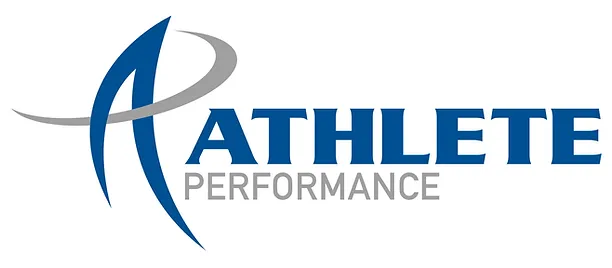
Experience the leading personal training software from Exercise.com by booking a demo now!
Understanding Multiple Sclerosis: A Comprehensive Guide
Living with Multiple Sclerosis (MS) can present unique challenges for individuals. As a fitness professional, it is crucial to have a comprehensive understanding of the condition and its impact on the body. This article aims to provide a detailed guide on training clients with MS, covering various aspects such as understanding the condition, tailoring exercise programs, assessing unique needs, and incorporating adaptive equipment.
Multiple Sclerosis is a chronic autoimmune disease that affects the central nervous system. It occurs when the immune system mistakenly attacks the protective covering of nerve fibers, causing disruptions in communication between the brain and the rest of the body. MS can result in a wide range of symptoms, including fatigue, muscle weakness, balance issues, and coordination problems.
It is essential to educate yourself about the different types of MS, such as relapsing-remitting MS, primary progressive MS, secondary progressive MS, and progressive-relapsing MS. Each type may require a different approach to training and exercise.
Furthermore, it is important to understand that while there is currently no cure for multiple sclerosis, there are various treatment options available to manage the symptoms and slow down the progression of the disease. These treatment options may include medication, physical therapy, occupational therapy, and lifestyle modifications.
The Importance of Exercise for Multiple Sclerosis Patients
Exercise plays a crucial role in managing the symptoms and improving the overall well-being of individuals with MS. Regular physical activity can help in reducing fatigue, improving strength and balance, enhancing cardiovascular fitness, and managing weight. Exercise also promotes mental well-being, combats depression and anxiety, and improves cognitive function.
However, it is essential to tailor exercise programs to accommodate the individual needs and abilities of clients with MS. As a trainer, you must balance the importance of pushing clients to achieve their goals while being mindful of their limitations and preventing overexertion.
One important consideration when designing exercise programs for individuals with MS is the type of exercise. While aerobic exercises like walking, swimming, and cycling are beneficial for cardiovascular fitness, strength training exercises are also crucial. Strength training can help improve muscle strength and endurance, which can be particularly beneficial for individuals with MS who may experience muscle weakness or spasticity.
In addition to the physical benefits, exercise can also have a positive impact on the immune system of individuals with MS. Research suggests that regular exercise may help regulate the immune response and reduce inflammation, which can contribute to the progression of MS. This highlights the importance of incorporating exercise as part of a comprehensive treatment plan for individuals with MS.
Tailoring Exercise Programs for Clients with Multiple Sclerosis
When designing exercise programs for clients with MS, it is crucial to take a holistic approach. Consider the individual’s current fitness level, specific symptoms, and any functional limitations they may experience. Assessments, such as strength testing, balance evaluations, and gait analysis, can provide valuable insights into their abilities and potential areas for improvement.
Develop a program that focuses on flexibility, strength training, cardiovascular exercise, balance and coordination, and functional movements. Incorporate exercises that target both upper and lower body strength, such as modified push-ups, seated or standing resistance band exercises, and leg presses.
Include cardiovascular exercises like walking, cycling, or swimming, depending on the individual’s capabilities and preferences. Balance and coordination exercises, such as single-leg stands or tandem walking, can be beneficial in improving stability. Lastly, prioritize flexibility and stretching techniques to maintain joint mobility and prevent muscle tightness.
It is important to regularly reassess and modify the exercise program as needed. MS symptoms can vary over time, so it is crucial to adapt the program to accommodate any changes in the individual’s abilities or limitations. Regular communication with the client and their healthcare team can help ensure that the exercise program remains effective and safe.
In addition to the physical benefits, exercise can also have a positive impact on mental well-being for clients with MS. Engaging in regular physical activity can help reduce fatigue, improve mood, and enhance overall quality of life. Encourage clients to set realistic goals and celebrate their achievements, no matter how small, to help maintain motivation and adherence to the exercise program.
Assessing the Unique Needs and Abilities of MS Clients
Each client with MS will have unique needs and abilities. Take the time to have open conversations with your clients to understand their goals, concerns, and limitations. Consider conducting thorough consultations and assessments to gather comprehensive information.
Assess the individual’s current level of functioning, including their range of motion, muscle strength, endurance, balance, and any sensory impairments. Additionally, inquire about any specific symptoms they experience, such as heat sensitivity or spasticity, which may impact their ability to exercise.
It is also important to assess the cognitive abilities of clients with MS. Cognitive impairments, such as difficulties with memory, attention, and problem-solving, can significantly impact their ability to participate in exercise programs effectively. Consider using cognitive assessments or working closely with a healthcare professional specializing in cognitive rehabilitation to gain a comprehensive understanding of their cognitive functioning.
Designing an Individualized Training Plan for MS Clients
Based on the assessments and consultations, design an individualized training plan that addresses the client’s unique needs and goals. This plan should take into account their physical abilities, limitations, and potential areas for improvement.
Structure the workouts to include a combination of cardiovascular exercise, strength training, balance and coordination exercises, and flexibility training. Gradually progress the intensity and duration of exercises based on the individual’s response and tolerance. Remember to incorporate appropriate rest and recovery periods to prevent overexertion and manage fatigue.
In addition to the physical aspects of the training plan, it is important to consider the psychological and emotional well-being of MS clients. Incorporate activities that promote stress reduction, relaxation, and mindfulness, such as yoga or meditation. These practices can help manage symptoms of anxiety and depression that may be associated with the condition.
Exercise Modifications for Different Stages of Multiple Sclerosis
As MS is a progressive condition, clients may experience changes in their physical abilities over time. It is essential to continuously monitor their progress and make appropriate modifications to their exercise programs as needed.
Adapt exercises based on the different stages of MS. In earlier stages, the focus may be on maintaining strength and mobility. As the condition progresses, modifications might be necessary to accommodate changes in balance, coordination, or muscle weakness. Be prepared to adjust exercises, intensity, or even equipment to maximize safety and effectiveness.
In the early stages of MS, individuals may benefit from incorporating aerobic exercises such as walking or swimming into their routine. These activities can help improve cardiovascular fitness and maintain overall endurance. Additionally, resistance training exercises using light weights or resistance bands can help maintain muscle strength and prevent muscle wasting.
As MS progresses, individuals may experience increased fatigue and difficulty with balance and coordination. In these later stages, exercises that focus on stability and balance, such as yoga or tai chi, can be beneficial. These activities can help improve core strength, flexibility, and body awareness, which can aid in maintaining balance and reducing the risk of falls.
Incorporating Strength Training into MS Client Workouts
Strength training is a valuable component of exercise programs for clients with MS. It helps maintain muscle strength, improve bone density, enhance functional movements, and support joint stability.
When incorporating strength training exercises, consider the specific needs and abilities of the individual. Utilize a variety of resistance training methods, such as free weights, machines, or resistance bands. Focus on targeting major muscle groups while also working on the weaker muscles affected by MS.
Exercises like seated or standing bicep curls, leg presses, chest presses, and modified push-ups can help improve overall strength and muscular endurance.
The Role of Cardiovascular Exercise in Managing Multiple Sclerosis Symptoms
Cardiovascular exercise is beneficial for clients with MS as it improves cardiovascular fitness, promotes circulation, and enhances overall well-being. It can also assist in managing weight, reducing the risk of secondary health complications, and combating symptoms such as fatigue and depression.
Encourage clients to engage in aerobic activities that are suitable for their abilities and interests. Walking, cycling, swimming, or using an elliptical machine are excellent options. Begin with shorter durations and gradually increase the duration and intensity of cardiovascular exercise as the individual becomes accustomed to the workouts.
Balance and Coordination Exercises for MS Clients
Balance and coordination exercises are vital in addressing the specific challenges faced by individuals with MS. These exercises help improve stability, reduce the risk of falls, and enhance body control.
Incorporate balance exercises like standing on one leg, heel-to-toe walking, or utilizing balance boards. Coordination exercises such as marching with high knees or performing controlled movements with resistance bands can further enhance coordination skills.
Flexibility and Stretching Techniques for MS Clients
Flexibility is crucial for maintaining joint health, preventing muscle imbalances, and minimizing the risk of injury for clients with MS. Stretching exercises can help improve joint range of motion, relieve muscle tension, and promote relaxation.
Incorporate dynamic stretches as part of the warm-up routine to prepare the muscles for activity. Static stretches, held for longer durations, can be included at the end of the workout sessions to enhance overall flexibility. Focus on major muscle groups, including arms, legs, back, and neck.
Adaptive Equipment and Assistive Devices for MS Clients during Training
When training clients with MS, it may be necessary to incorporate adaptive equipment and assistive devices to maximize safety and effectiveness. Examples of adaptive equipment include resistance bands, stability balls, and modified exercise machines.
Additionally, consider using assistive devices like walkers, canes, or walking poles to aid balance and stability during certain exercises. Ensure proper instruction and practice with the equipment to ensure clients are using them correctly and safely.
Addressing Fatigue and Energy Conservation Strategies in MS Client Workouts
Fatigue is a common symptom experienced by individuals with MS and can significantly impact their ability to engage in physical activity. As a trainer, it is essential to incorporate strategies that address fatigue and promote energy conservation during workouts.
Implement a graded exercise approach, gradually increasing the intensity and duration of workouts over time. Encourage clients to listen to their bodies and take breaks when needed. Incorporate proper rest periods between exercises and stay vigilant for signs of exertion or fatigue during sessions.
Tips for Effective Communication and Motivation with MS Clients
Effective communication and motivation are vital when working with clients with MS. Establish an open and supportive communication channel that allows clients to express their concerns, share their progress, and ask questions.
Set realistic and achievable goals with your clients. Celebrate their successes and provide positive reinforcement along the way. Adapt training methods to their individual preferences and interests, making the workouts enjoyable and motivating.
Monitoring Progress and Adjusting Training Plans for Best Results in MS Clients
Regularly monitor the progress of clients with MS to track their improvements and make necessary adjustments to their training plans. Regular reassessment can help identify areas that require additional attention or modification.
Keep detailed records of their performance, physical changes, and any symptoms they may experience. This documentation will inform future decisions in modifying exercise programs and ensure ongoing progress.
Common Challenges and Solutions in Training Clients with Multiple Sclerosis
Training clients with MS can present unique challenges, including mobility limitations, fatigue, temperature sensitivity, balance issues, and coordination difficulties. Be prepared to adapt exercise plans, modify equipment, and provide constant support.
Consult with healthcare professionals who specialize in MS for guidance and collaborate with other members of the client’s healthcare team to ensure a comprehensive and coordinated approach to care.
Real-Life Success Stories: Inspiring MS Clients through Fitness Training
Nothing is more inspiring than real-life success stories of individuals with MS reclaiming their lives through fitness training. Share stories of clients who have made significant progress, improved their symptoms, and achieved their fitness goals despite living with MS.
By sharing these stories, you can motivate and inspire other individuals with MS to embark on their fitness journeys, encouraging them to embrace the benefits of exercise in managing their condition.
Training clients with Multiple Sclerosis requires a comprehensive understanding of the condition and its impact on the body. By tailoring exercise programs, assessing unique needs, incorporating adaptive equipment, and addressing specific challenges, fitness professionals can make a significant difference in the lives of individuals living with MS. Through effective communication, motivation, and ongoing monitoring, trainers can empower their clients to achieve their goals, improve their symptoms, and enhance their overall well-being.
How do you train a client with multiple sclerosis?
When training a client with multiple sclerosis (MS), it’s important to consider their individual abilities, limitations, and symptoms. Focus on exercises that improve balance, flexibility, strength, and cardiovascular fitness. Low-impact activities such as swimming, cycling, walking, and yoga can be beneficial. It’s crucial to listen to the client’s needs, adjust the intensity as necessary, and encourage regular breaks if fatigue or other symptoms arise.
What exercises are good for multiple sclerosis patients?
Exercises that are good for multiple sclerosis patients include low-impact aerobic exercises like swimming or cycling, flexibility exercises such as yoga or tai chi, strength training with light weights or resistance bands, and balance exercises. It’s important to tailor the exercises to the individual’s abilities and consider any specific symptoms or limitations they may have.
What exercises should be avoided for a patient with multiple sclerosis?
Exercises that involve high-impact activities, extreme temperatures, or prolonged periods of exertion should generally be avoided for patients with multiple sclerosis. It’s also important to pay attention to the individual’s symptoms and adjust exercises accordingly. Exercises that increase the risk of falls or injury should be approached with caution.
Does strength training help multiple sclerosis?
Yes, strength training can be beneficial for individuals with multiple sclerosis. It can help improve muscle strength, endurance, and overall physical function. However, it’s important to use appropriate weights and avoid overexertion. As always, it’s essential to consult with a healthcare professional before starting any new exercise program.
Can physical activities actually help people with multiple sclerosis?
Yes, physical activities can be beneficial for people with multiple sclerosis. Regular exercise can help improve overall fitness, reduce fatigue, improve mood, increase muscle strength, and improve mobility and coordination. It’s important to find activities that are enjoyable and suitable for the individual’s abilities and symptoms.
What aggravates multiple sclerosis?
Multiple sclerosis can be aggravated by factors such as extreme heat, stress, infections, and physical or emotional exhaustion. It’s important for individuals with MS to manage these triggers and seek guidance from healthcare professionals to develop coping strategies.
What is the primary barrier to exercise for those with MS?
Fatigue is often the primary barrier to exercise for individuals with MS. It’s important to listen to the client’s body and allow for rest and recovery when needed. Gradually increasing exercise duration and intensity can help manage fatigue levels.
What physical therapy exercises for sclerosis?
Physical therapy exercises for multiple sclerosis may include stretching exercises, range-of-motion exercises, balance and coordination exercises, functional exercises, and aerobic exercises. The specific exercises will depend on the individual’s symptoms and limitations, and should be guided by a healthcare professional.
What lifestyle advice would you recommend for multiple sclerosis?
Some lifestyle advice for individuals with multiple sclerosis includes maintaining a balanced and nutritious diet, managing stress, getting enough rest and sleep, staying hydrated, avoiding excessive heat, and engaging in regular physical activity. It’s also important to work closely with healthcare professionals to manage symptoms and develop an appropriate treatment plan.
What is the dietary teaching for a client who has multiple sclerosis?
While there is no specific diet for multiple sclerosis, maintaining a healthy and balanced diet is generally recommended. This includes consuming a variety of fruits, vegetables, whole grains, lean proteins, and healthy fats. Some evidence suggests that a diet rich in omega-3 fatty acids, such as those found in fish, may be beneficial for individuals with MS. It’s important for individuals with MS to work with a healthcare professional or registered dietitian to develop a dietary plan that meets their specific needs and preferences.
Use the Best Personal Training Software to Offer a Stellar Client Experience
Training clients with back pain requires a comprehensive and tailored approach. See how Exercise.com can help.

To learn more about how Exercise.com can help you run your fitness business, book a demo now!
Creating Training Plans for Clients with MS
Here’s how you can help your clients accomplish their training goals by using workout plan creator software to create workout plans, run fitness challenges, offer online workout groups, message clients, and more, all from your very own custom branded fitness apps.
Exercise.com stands out as an all-in-one fitness business management software with comprehensive workout plan sales capabilities. The robust member management, billing & invoicing, and unique fitness assessment tools offer a one-stop solution for fitness business needs. Here’s just some of what you can do with the Exercise.com platform:
Engage with clients via automations.
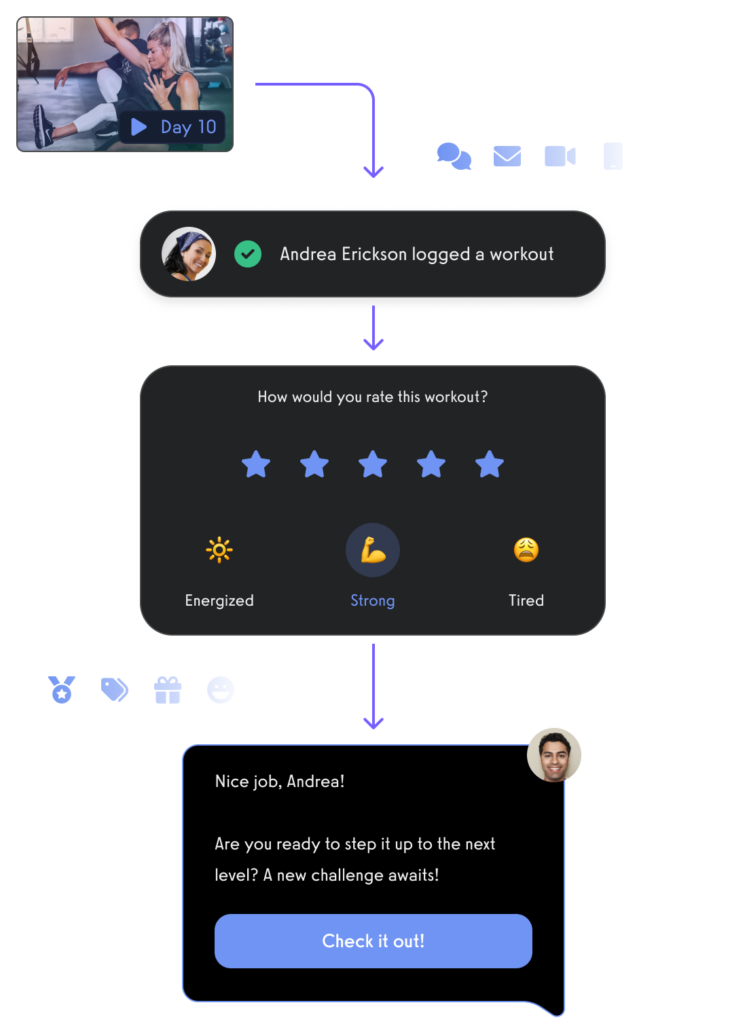
Manage leads with a fitness CRM.

Create and send fitness assessments with ease.
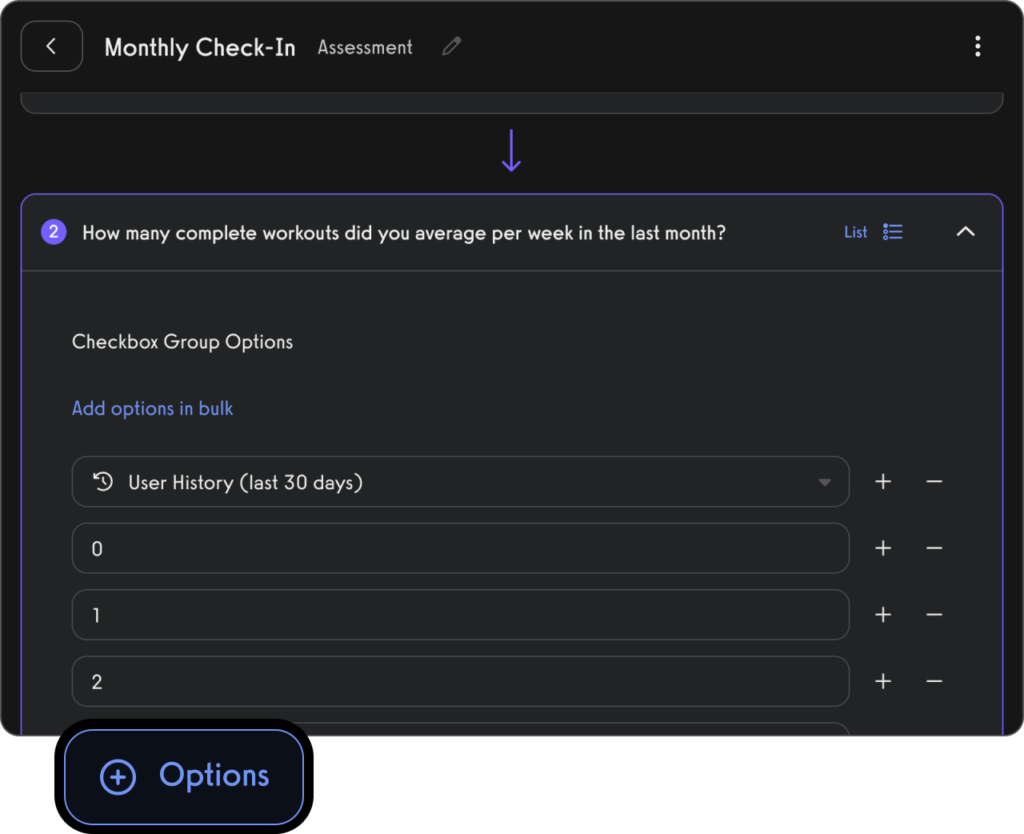
Use fitness habit tracking to inspire and motivate personal training clients (in-person and remote).

Use fitness progress photos to engage with clients.
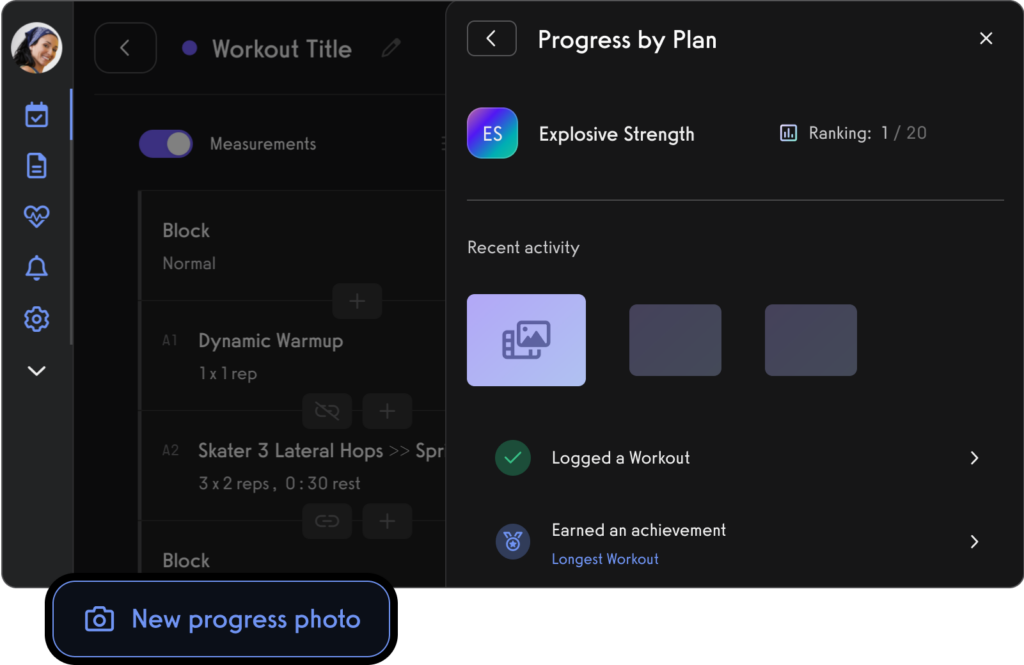
Use fitness leaderboards to track performance and inspire healthy competition.
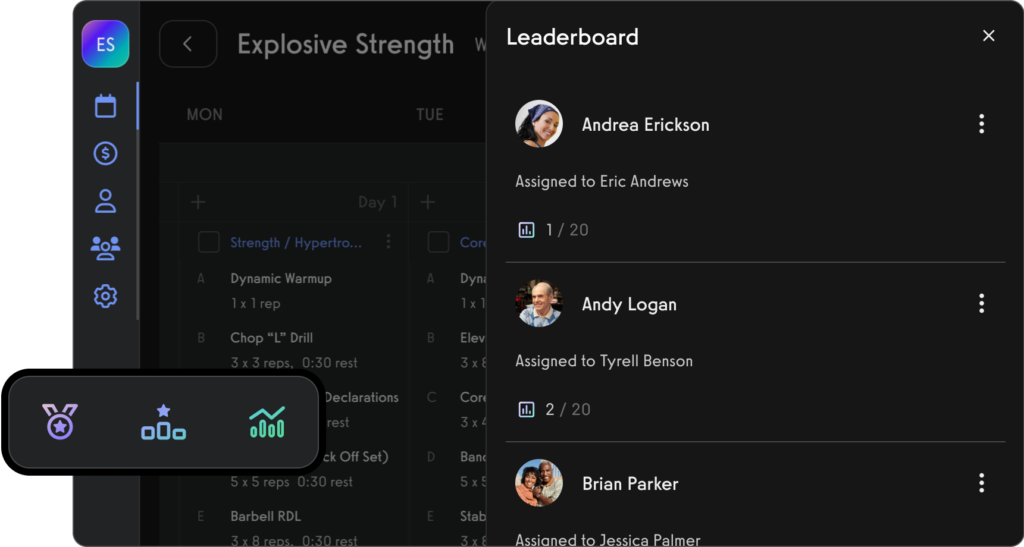
Use the exercise demonstration video library or create your own custom exercise demonstration videos.

Create workout plans for parents and dependents, teams and more.

Manage personal training clients with ease.

Book appointments for clients (Read More: Best Gym Booking Software)

Create classes and fitness groups

Manage fitness challenges (Read More: 100+ Fitness Challenge Ideas)
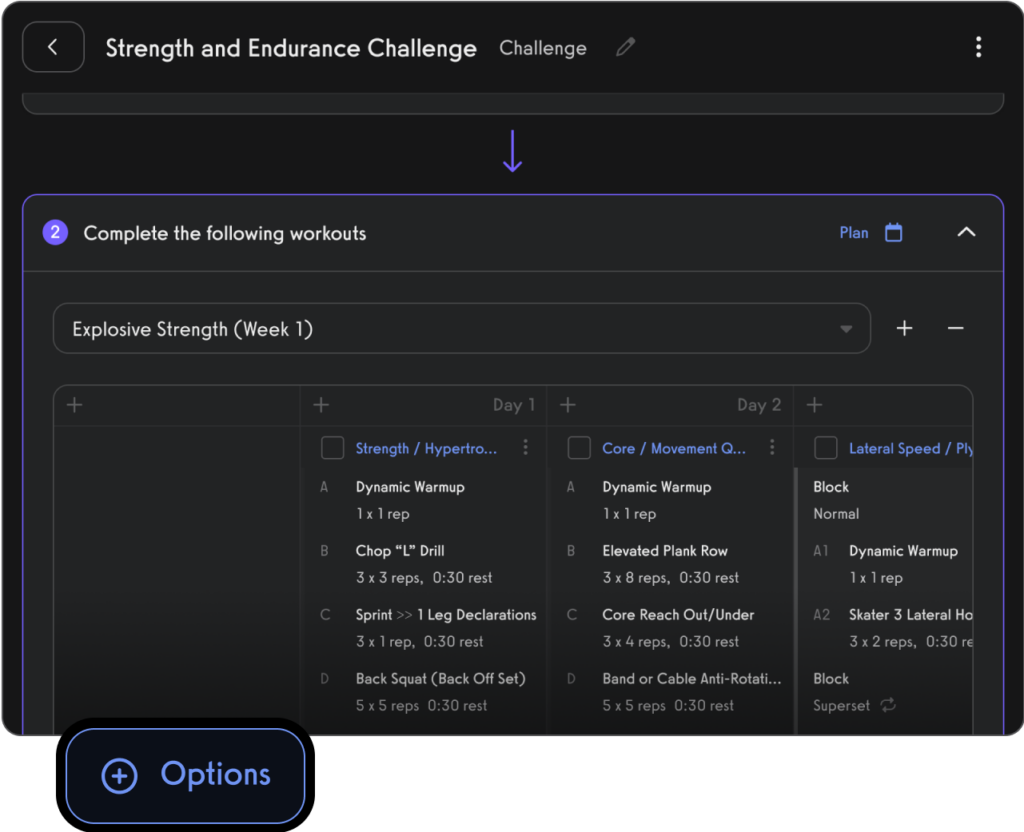
Process payments for open gym, classes, and personal training.

Communicate with gym members, athletes, team members, personal training clients, class members, parents, and dependents via SMS, email, and in-app push notification.
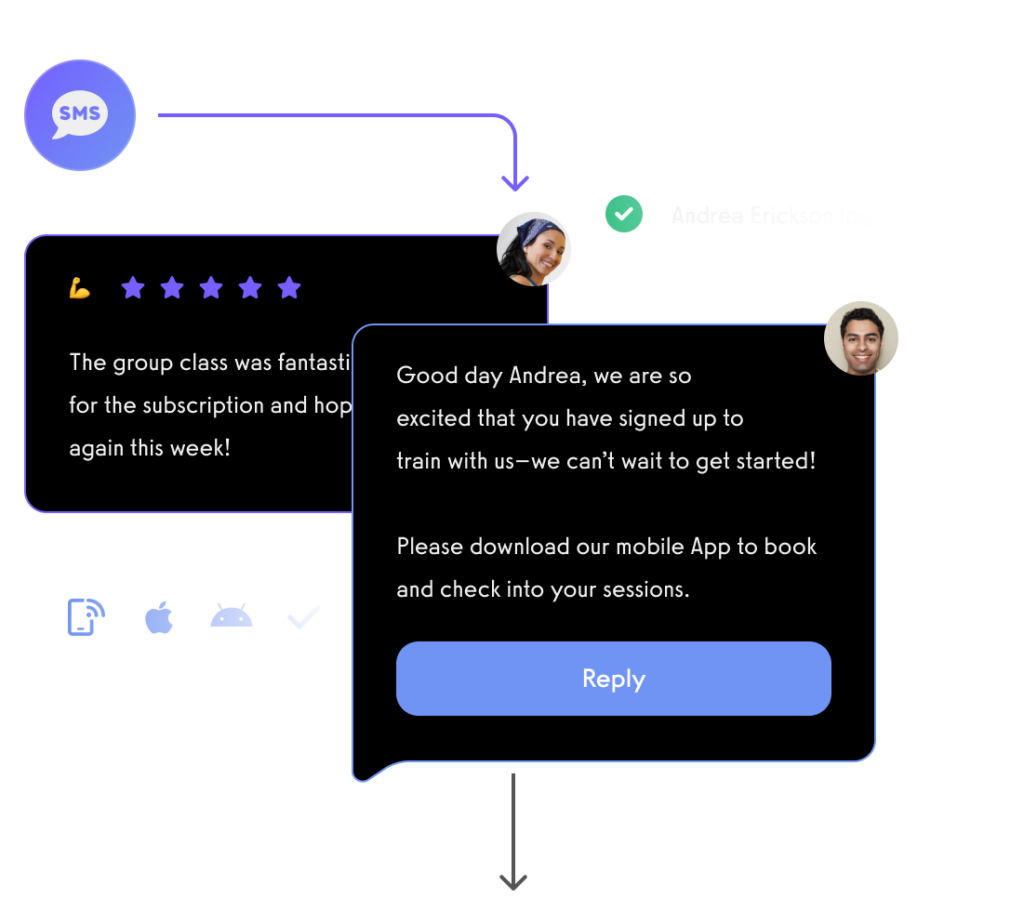
View performance over time, track personal records, and other fitness stats with performance reporting dashboards.
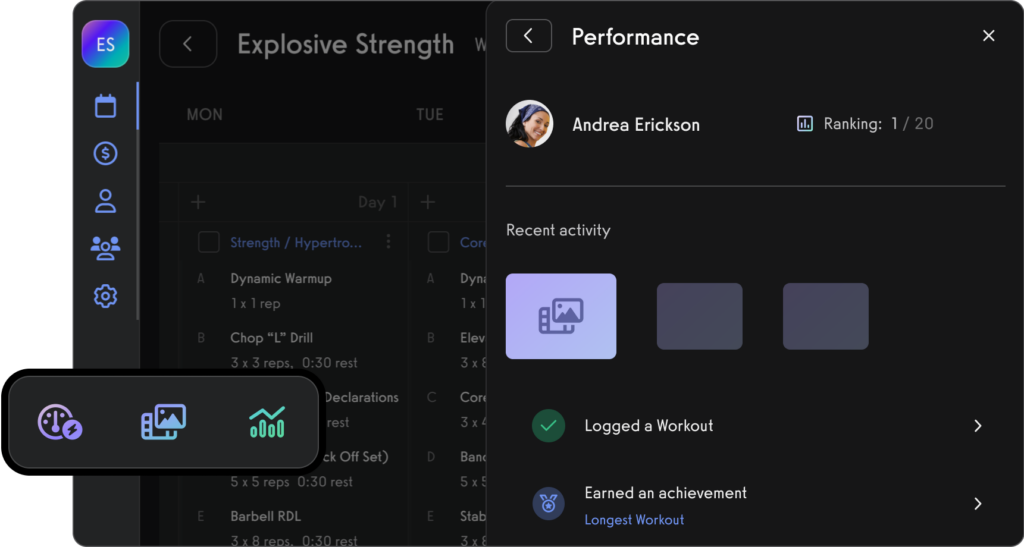
And of course, view all of your fitness business reports easily too.

All from your custom-branded fitness apps (Read More: Best Gym Mobile Fitness Apps Software)

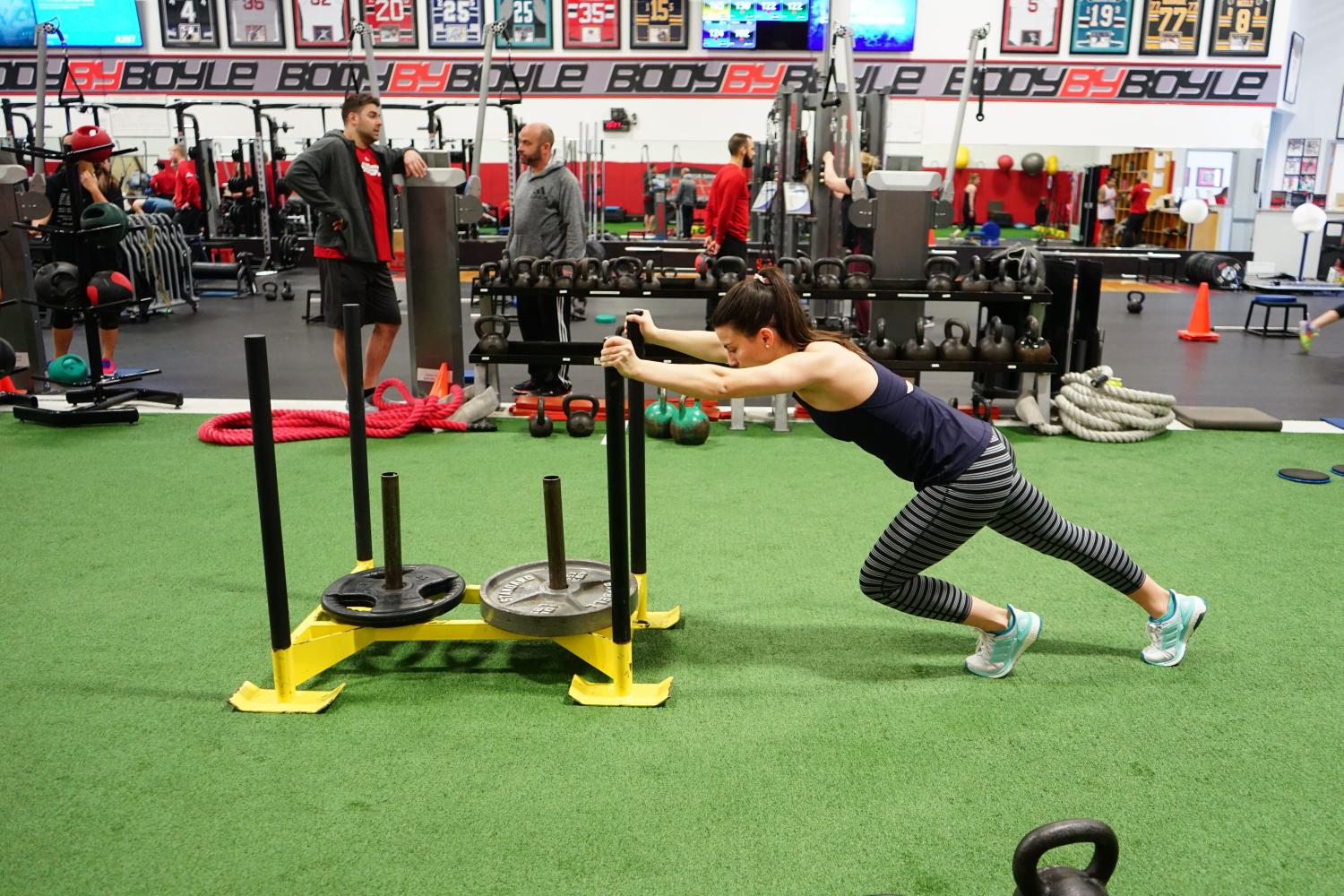
Want to learn how your fitness business can take it to the next level? Get a demo now!









